Chest and biceps aren’t often paired on upper-body days, but they can go quite well together. These two muscle groups don’t interfere with each other much, as they’re alternate-peripheral pairs. This means that, for the most part, the exercises for them don’t overlap.
It is true that the triceps are heavily recruited in nearly all pressing exercises as agonists, with the biceps being antagonists. However, the overlap between exercises and subsequent fatigue between an alternate-peripheral or agonist-antagonist pair is likely to be smaller than an agonist-agonist pair such as chest and shoulders or chest and triceps. Because the exercises that train each muscle group don’t overlap as much, it is likely that you’ll be able to lift heavier weights and complete more training volume than when combining another pairing.
Whether this leads to more strength or size improvement than a different pairing is up for debate. However, pairing the chest and biceps is a viable setup for a body-part split, likely accompanying additional leg and shoulders along with back and triceps training days.
In any case, when you push something away from your body, your chest plays the main role, and when you turn your palm over to face upwards or lift something closer to you by bending the elbow, your biceps do the heavy lifting.
Our favorite chest and biceps exercises for your upper body workout days: the flat barbell bench press, incline dumbbell bench press, push-ups, and cable crossover for the chest, and the preacher curl, dumbbell curl, and concentration curl for the biceps.
What are the Best Chest and Biceps Workout Exercises?
- Flat barbell bench press: 3-4 sets x 5-8 repetitions
- Incline dumbbell bench press: 2-4 sets x 6-10 repetitions
- Push-ups: 3 sets x 10 – 30 reps
- Cable crossover: 2-4 sets x 10-15 repetitions
- Preacher curl: 3-4 sets x 8-12 repetitions
- Dumbbell curl: 3-4 sets x 10-15 repetitions
- Concentration curl: 3-4 sets x 10-15 repetitions
1. Flat Barbell Bench Press
Suitable for both newbies and pro lifters alike, flat barbell bench presses are a gym classic for a reason: they’re great in increasing strength and hypertrophy in many upper-body muscle groups, including the chest, arms, and shoulders. The barbell bench press specifically targets the pectoralis major, anterior deltoid, triceps brachii, biceps brachii, and serratus anterior.
You can perform the exercise as a stand-alone or add it to your current workout routine. The bench press can improve performance for sports athletes — for instance, there’s data suggesting that upper body strength, as measured by the bench press, is linked with greater club head speed in golfers and punching speed in boxers. [1, 2]
Equipment-wise, you need a bench, barbell, and a squat track to do the flat barbell bench press.
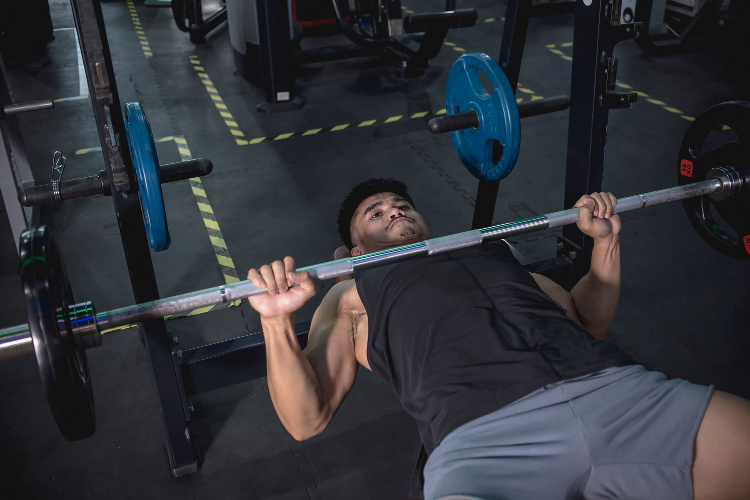
Movement Category: Primary
Programming: 3-4 sets of 5-8 repetitions
Weight: Use a weight that leaves you 2 to 3 reps short of failure, e.g., RPE 7 to 8.
Flat Barbell Bench Press Instructions
- Lie down on the bench and position your head slightly in front of the barbell when seen from the side. This makes sure there’s enough room for the bar to go up and down without hitting the rack.
- Take the bar using an overhand grip. Hold the bar one-to-two-hands’ width wider than shoulder distance apart.
- Prior to lifting the bar off the rack, fix your eyes on a point on the ceiling towards your feet rather than directly above you. Pull your shoulder blades back into the bench.
- Take the bar out of the rack and hold it over your shoulder joints.
- Inhale and hold your breath.
- Bring the bar down until it reaches your sternum — around 2-to-3 inches forward of where the bar began over your shoulder joint. While staying in this position, your humerus and elbows are supposed to be at a ~30 to 45-degree angle to the torso.
- Push the barbell up and back so that it lands directly over your shoulder joint.
2. Incline Dumbbell Bench Press
A variation of the bench press, the incline dumbbell bench press utilizes an inclined bench to target the upper pectoralis major. Though the incline dumbbell bench press works on the whole pectoralis major, it particularly isolates the clavicular head. [3] Another engaged area is the anterior deltoid, the main shoulder muscle. In comparison to some other bench press variations – including the standard one – the incline bench press utilizes a greater range of motion, with a movement path that’s 50% longer than the average.
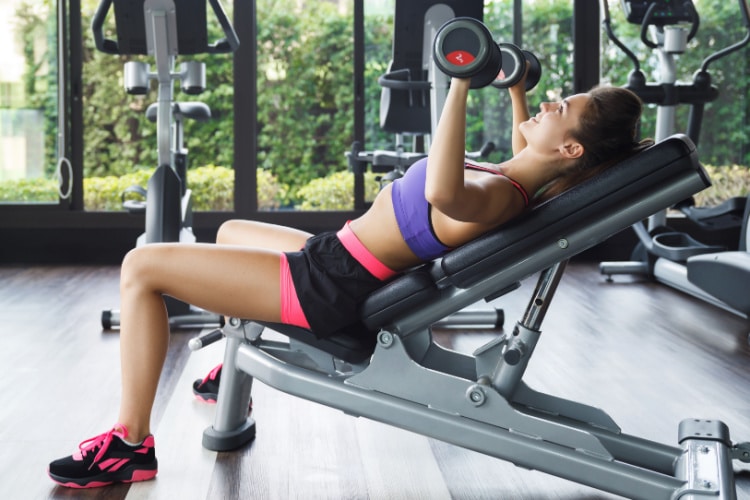
Movement Category: Secondary
Programming: 2-4 sets of 6-10 repetitions
Weight: Use a weight that leaves you 2 to 3 reps short of failure, e.g. RPE 7 to 8.
To do an incline bench press:
- Bench inclination should be 15-30 degrees.
- Lie flat on your back and press your shoulder blades into the bench. Feet are firmly grounded on the floor.
- Inhale deeply. Then lift as you exhale.
- Ask someone to spot you, if needed.
- Take a few seconds at the top to get used to the weight. Keep the upper back muscles engaged.
- Breath in, then slowly lower the barbell to the lowest position – at your breastbone’s base.
3. Push-Ups
Hands-down, one of the most popular exercises, push-ups are part of most training routines, regardless of whether you frequent the gym or exercise from the comfort of your home. Performing push-ups strengthens your upper-body muscles, including the chest, shoulders, upper and middle back, biceps, and triceps. They’re also great because you don’t need any additional equipment to do them – just your body weight.
Although they’re easily accessible, don’t underestimate push-ups. For instance, a study compared four weeks of doing either push-ups or bench presses three times per week. Participants in both groups had almost identical improvements in 1RM bench press strength and chest hypertrophy. [3] Another study on male firefighters suggests that being capable of doing more push-ups is connected to a lower risk of cardiovascular issues such as strokes or heart attacks. [4] According to this research, individuals who can do more than 40 push-ups have a lower risk of heart problems as opposed to those who can do fewer than 10. What’s more, adding exercises such as push-ups to your aerobic exercise program may boost energy metabolism, thus burning more calories. This leads to benefits such as greater fat loss. [5]
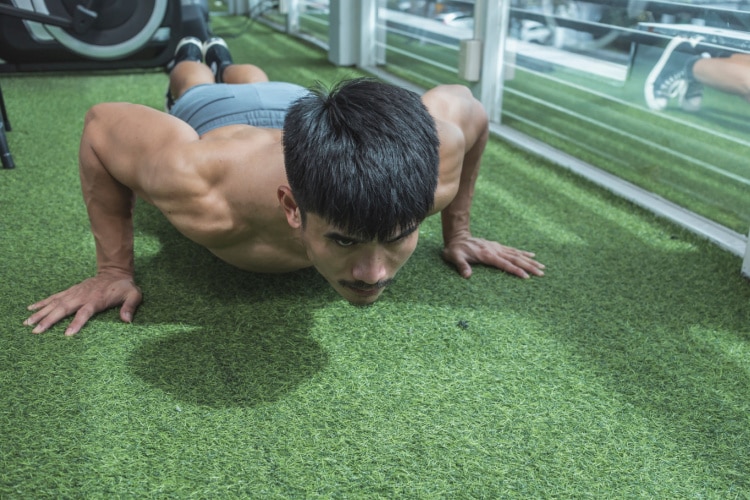
Movement Category: Tertiary
Programming: 3 sets of as many reps as it takes to get within 2 to 3 reps short of failure, e.g. RPE 7 to 8.
Weight: Bodyweight
Push-Up Instructions
- Get into a quadruped position. Ensure your hands are below your shoulders, your knees beneath your hips, and that your toes are tucked. Keep your arms straight and face the ground.
- Straighten one leg at a time, lifting the knees off the ground, and come into plank position.
- When you’re in plank, retract your shoulder blades and unlock your elbows to slowly lower your body towards the ground. Make sure that your body’s in a straight line, as otherwise you risk decreasing muscle engagement.
- Resume lowering your body until your chest nearly reaches the ground.
- Straighten your elbows and push the ground with both hands to get back to the beginning position.
- Stretch out your shoulder blades at the top.
4. Cable Crossover
Although the exercise primarily targets the pectoralis major, it also activates the following muscles: anterior deltoid, serratus anterior, biceps brachii, trapezius, and rhomboids.
The cable crossover allows for ongoing tension on the chest muscles throughout the entire exercise, which maximizes muscle engagement. According to research, cable exercises generally provide an improved range of motion. [6, 7] Also, standing cable exercises bring about better mobility in your knees, shoulders, and hips. [8]
As the name suggests, you’ll need a cable machine to do cable crossovers.
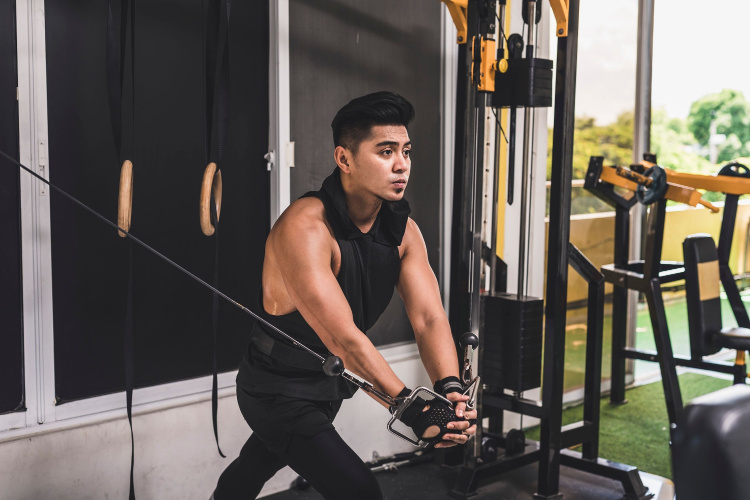
Movement Category: Tertiary
Programming: 2-4 sets of 10-15 repetitions
Weight: Use a weight that leaves you 1 to 2 reps short of failure, e.g. RPE 8 to 9.
Cable Crossover Instructions
- Raise both handles on the sides to the highest position and attach the single grip handles.
- Place your chosen weight on the stacks, and grab each handle with your palms.
- Take a step forward.
- Hold your chest up high and focus your eyes forward. Slightly bend your arms at the elbows.
- Pull the cables in an arc motion towards the center in front of your chest, letting your hands cross over one another at the top of the movement.
- Stay in this position for a moment.
- Then, slowly let your arms return to the beginning position until you feel a stretch in your pecs as you take a deep breath.
- Alternate which arm is on top for each rep.
Cable machines provide trainees with several handle positions depending on which part of the chest you want to target. With the cable crossover specifically, you have three options:
- A low cable crossover allows you to target the upper chest;
- A high cable crossover allows you to target the lower chest;
- A middle cable crossover allows you to target the middle and inner chest.
5. Preacher Curl
A variation of the standard biceps curl, the preacher curl is an exercise performed with a preacher bench, where you sit down with your upper arms resting on a surface tilted inward. It’s an exercise that allows you to hone in on your biceps without engaging any other body parts. Since you’re seated, and your upper arms are fixed on the pad, this position allows for greater engagement of your biceps — and it primarily targets the biceps brachii.
You can do the preacher curl with barbells, dumbbells, kettlebells, or even resistance bands.
In general, using a large range of motion for an exercise produces more hypertrophy than a shorter one, particularly if the muscle or muscle group is trained at relatively short lengths. [9]
Performing exercises for a partial range of motion, but at long muscle lengths, e.g. lengthened partials, may work just as well for hypertrophy when compared to a traditional, full range of motion for some exercises. [10]
Another study comparing the response of biceps brachii to two preacher curl exercises, the first done on a cable-pulley system (in which greater torque is applied, the elbows are flexed, and the biceps shortened), and the second one done with a barbell (in which greater torque is applied when the elbows are extended and the biceps stretched), found the following: muscular strength gains were greater for the former exercise only at larger muscle length; on the other hand, hypertrophy was more or less the same irrespective of whether the torque emphasis was carried out in the final (cable-pulley system) or initial (barbell) levels of the range of motion. [11]
To perform the preacher curl exercise, you need a preacher bench.
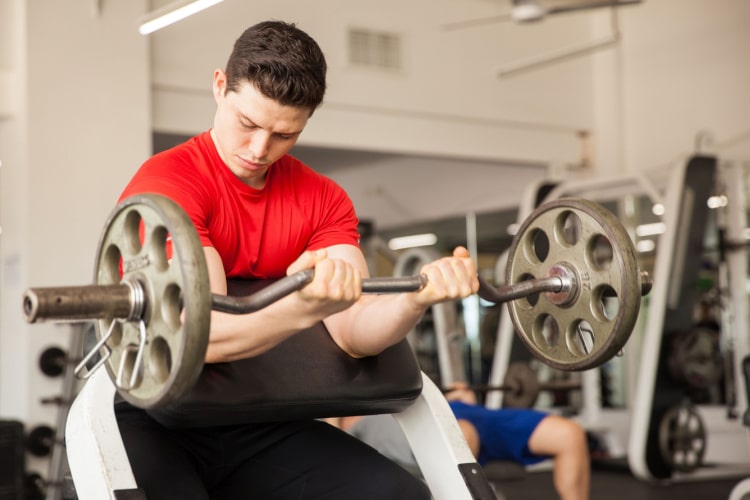
Movement Category: Tertiary
Programming: 3-4 sets of 8-12 repetitions
Weight: Use a weight that leaves you 1 to 2 reps short of failure, e.g. RPE 8 to 9.
Preacher Curl Instructions
- We’ll illustrate this exercise with a barbell. Take the barbell with an underhand grip and sit on the preacher curl bench. Make sure both feet are flat on the ground. Adjust the seat in a way that allows your chest and upper arm to touch the arm pad. Keep your chin tucked during the entire movement. Your arms need to be long, with a slight bend in both elbows. Keep a neutral wrist position.
- Begin the upward movement by squeezing both biceps and bending your elbows. Resume with lifting until the barbell is at shoulder level.
- Complete the movement by squeezing your biceps.
- Straighten your elbows to lower the barbell to the beginning position.
Don’t do the exercise with your elbows too high (if the seat is too high) or too low (if you’re sitting too low). Also, some preacher curl machines have distinct grip options, like under or parallel grip, so go with what feels right for you.
6. Dumbbell Curl
The dumbbell curl is an isolation movement which uses elbow flexion to lift the dumbbells. This exercise allows for a wider range of motion while training the biceps, as opposed to the barbell curl. Although primarily targeting the biceps, nearby muscles such as the forearm flexors and brachialis act as stabilizers.
A biomechanical analysis of dumbbell curls exploring the effects of increasing the loads on the biceps brachii found that increasing this load doesn’t increase the muscle force at the same rate. [12]
Yet another study whose purpose was to investigate the influence of various dumbbell weights on the biceps brachii muscle during this exercise discovered that the correlation between muscle force increase and muscle contraction isn’t linear. As a piece of research, this study allows us to understand muscles’ responses to different loads. [13] That said, the dumbbell curls are usually performed in higher volume sets, just with a low amount of weight.
To perform the dumbbell curl, you need a pair of dumbbells.
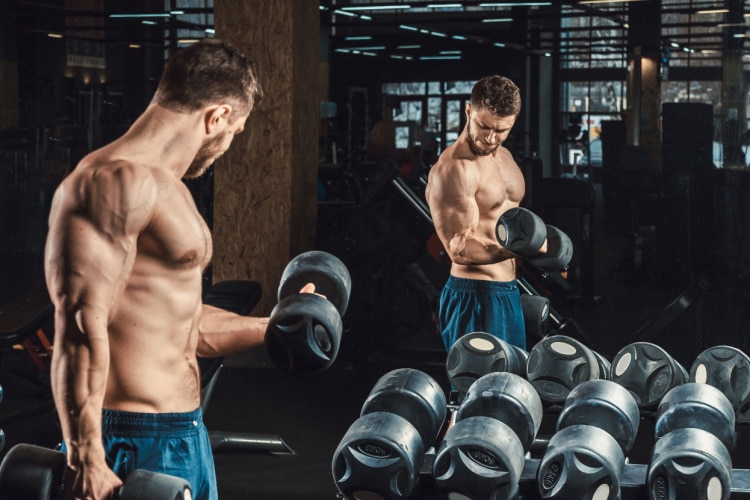
Movement Category: Tertiary
Programming: 3-4 sets of 10-15 repetitions
Weight: Use a weight that leaves you 1 to 2 reps short of failure, e.g. RPE 8 to 9.
Dumbbell Curl Instructions
- Stand straight, holding a dumbbell in each hand with a supinated grip (your palms facing upward).
- Relax your shoulders and engage your core. Have your arms hanging down by the side of your body.
- Squeeze your biceps while keeping your elbows close to each side of the body. Bend at the elbows to curl the dumbbells up to the shoulder.
- Lower both dumbbells bit by bit until your arms are completely extended, and you’ve returned to the beginning position.
Don’t let the dumbbells touch your body. Also, don’t swing your body back as you curl up the weight. Instead, keep your body fixed during the entire movement. Your forearms should be the only part that’s moving.
7. Concentration Curl
Also known as the dumbbell concentration curls, the concentration curls are a variation of the traditional biceps curls. This is an exercise that truly allows you to isolate your biceps much more effectively than any other curl variation.
Research suggests that concentration curls are the prime exercise to isolate your biceps muscle. A study conducted by the American Council on Exercise explored which exercise was the most beneficial for activating the biceps brachii. The researchers compiled a list of the eight most popular biceps exercises: the cable curl, barbell curl, concentration curl, chin-up, EZ curl (with both wide and narrow grip), incline curl, and preacher curl. Their results suggest that the concentration curl is better than the rest of the exercises, as it elicited noticeably higher muscle activation of the biceps than any of the other exercises tested. [14]
Equipment-wise, you need a dumbbell and a bench to perform the concentration curl.
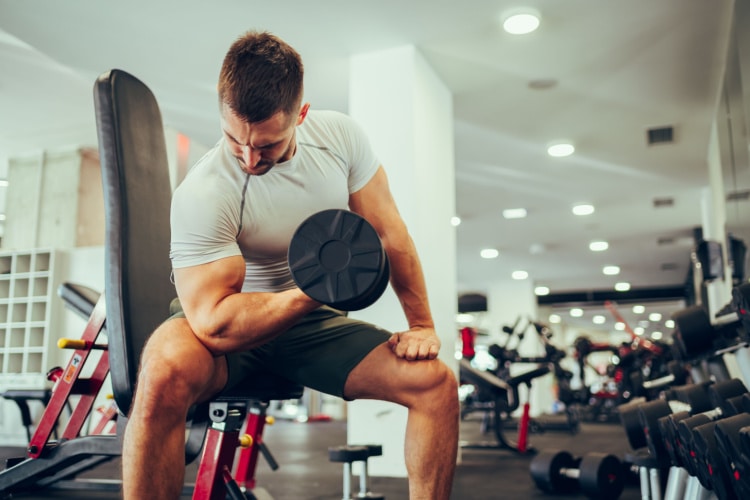
Movement Category: Tertiary
Programming: 3-4 sets of 10-15 repetitions
Weight: Use a weight that leaves you 1 to 2 reps short of failure, e.g. RPE 8 to 9.
Concentration Curl Instructions
- Get a dumbbell and sit on a flat bench. Ensure your legs are wider than your hips.
- Hinge from your hips and move your upper body toward your legs (keep your upper body at a 45-degree angle).
- Put the elbow of the curling arm on the inside of your leg. Place the other hand on the same leg to ensure stability. The curling arm is supposed to be extended, with a slight bend at the elbow. Keep the dumbbell close to your lower leg and have the palm facing away from your leg.
- Rotate your shoulder outward, keeping your core engaged.
- Keeping your upper arm in contact with the inside of your leg, squeeze the bicep and bend the elbow until your lower arm touches your upper arm. The dumbbell should end up close to your shoulder without touching it.
- At the peak of the movement, squeeze your bicep for a second.
- Straighten your elbow to start lowering the dumbbell to the beginning position.
Avoid overcurling. Many trainees believe they have to get the dumbbell to touch their shoulders, which isn’t quite the case. Go as high as you can before your triceps loses contact with your thigh. As long as your forearm is higher than parallel to the floor and your triceps is touching your thigh, your biceps will remain engaged. But go any higher than that and the elbow begins shifting forward, and the exercise no longer isolates the biceps.
The Chest and Biceps Anatomy
The body functions as a whole — no part of it works completely in isolation from the other parts. This means that in order to understand chest and biceps anatomy, we need to frame them within the context of the entire body.
The human skeleton consists of axial and appendicular portions. The first entails the skull, the vertebrae of the spine, the sternum, and the ribs; the latter comprises the limbs and their girdle, which attaches the limbs to the axial skeleton. [15] The shoulder girdle consists of two bones — the collarbone and the shoulder blade. These two bones are in close connection with the humerus. The bones of the shoulder girdle and those of the axial skeleton have the role of attachment links for muscles that enable the humerus to move during activities.
The shoulder girdle consists of many distinct muscles, as the scapula and the humerus connect to 17 and 13 different muscles, respectively. [16, 17] As far as chest muscles go, these are muscles that link the arm with the front and side thoracic wall. The thoracic walls surround the space between the neck and the diaphragm, which is basically where your heart and lungs are located. The area beneath the diaphragm going all the way to the pelvis is called the abdominal cavity, which is where organs such as your kidneys, intestines, and liver are situated. [18]
Chest
The chest is a large muscle group including:
- The pectoralis major, the largest chest muscle of the chest wall. In males, it’s located beneath the skin and subcutaneous fat. In females, it’s below the breast tissue. The pectoralis major has two heads — the clavicular head, emerging from the clavicle and the larger sternocostal head, emerging from the sternum, the upper costal cartilages of the ribs, and the sheet-like tendon of the external oblique muscle. [19]
- The pectoralis minor, a triangular-shaped muscle, located just beneath the pectoralis major.
- The serratus anterior, a fan-shaped muscle beginning from the sides of the first eight or nine ribs and stretching all the way to the scapula.
- The subclavius muscle, a short triangular muscle found just beneath the clavicle.
Biceps
As far as the biceps is concerned, the easiest way to describe it is by thinking of it as a thick muscle on the anterior or front portion of the upper arm. The biceps brachii is made up of a short head (caput breve) and a long head (caput longum). [20] The long head emerges from the supraglenoid tubercle above the “socket” of the shoulder joint (glenoid cavity) on the shoulder blade (scapula), whereas the short head emerges from a bony projection off the front of the scapula called the coracoid process of the scapula.
The biceps’ main function is to flex (bend) the elbow and supinate the forearm. To visualize these two movements, think of turning your hand palm up, which is supination) and, afterward, pulling your palm-up hand to your face (flexion). [21] The biceps’ antagonist is the triceps brachii muscle. [22]
Training Chest and Biceps Together
The way you group your exercises or combine several muscle groups in a single workout depends on how you like to plan your training routine. If you prefer to exercise each body part on a particular day, a body-partsplit would be ideal. In that scenario, paring the chestand biceps because they’re alternative-peripheral movements is a viable setup to accompany additional leg and shoulders and back and triceps training days.
In this scenario, we think that starting with your chest and then moving to your biceps is a good setup. This may come naturally to you, and it’s not a bad idea to follow this order – targeting larger muscles (the chest) first with multi-joint (compound) exercises and then moving on to single-joint (isolation) exercises targeting smaller muscles (biceps). The data on exercise order is relatively clear regarding strength, suggesting that exercises performed earlier in the workout seem to generate greater gains in strength than if they’re performed later on. With respect to hypertrophy, however, there’s no clear signal that training a particular muscle group first – or whether or not they’re compound or isolation exercises – matters much for muscle growth. Regardless of order, results may be about the same. [23]
In any case, we recommend multi-joint exercise, like the bench press, as a starter. If you ask us, the superior strength gains make this approach worth it. [24]
Tips for an Effective Chest and Biceps Workout
Effective chest and biceps workouts require proper planning and adhering to some safety tips.
1) Choose a suitable volume
It’s not uncommon to combine various workout regimens and exercises; the challenge lies in determining the appropriate exercises and the proper “dose” for each individual.
For example, if the dose of the workout is much higher than what’s necessary, you may end up with too many muscle protein breakdowns from the workout, which won’t help you increase muscle size. Muscle growth is only possible when training is designed in a way that minimizes the breakdown of muscle proteins and promotes their synthesis. [25, 26] Securing strength gains also becomes unlikely if the training dose, overall workout intensity, or exercise selection are off. [27, 28, 29]
2) Progressive loading is necessary
By gradually increasing the level of overload, hypertrophy training continuously grows your muscles. The “Progressive Overload” Principle states that in order for the body to gradually produce fitness adaptations, it must be subjected to increasingly intense training stimuli. The exercise regimen must be constantly adjusted as you move through higher levels.
Having said that, progressive overload is often misinterpreted because people believe that in order to achieve better results, the training must become more difficult. That isn’t the case. Rather than using the phrase progressive overload, we prefer going with the term progressive loading to prevent such misunderstandings. The number of repetitions that trainees can perform must increase in tandem with their improved power and fitness. It is only by matching the training to each individual’s fitness level that we can be sure that the body receives the right signal to alter its size.
3) See us if you’re currently injured
For starters, if you feel any sort of alarming pain – stop the exercise immediately. [30] However, there are many sorts of pain (some of it good – think about sore muscles after a great workout!), so it’s helpful to educate yourself on what different pain means. We recommend reading our article on pain in training and what to do and how to find your entry point to exercising.
Beyond that, however, if you’re currently injured, do consider getting in touch with us. Our coaching team includes physicians and rehab professionals that’ll help you get back on track, safely.
The good news is that most healthcare professionals don’t rank safety as a major concern when recommending exercises. The risk of injury from resistance training is quite low at ~ 2 to 4 injuries per 1,000 participation hours, or 1-2 injuries per lifter per year. [31, 32]
Plus, most injuries are not debilitating, and usually resolve on their own within 2 weeks. In fact, lifting has a low injury rate and injury severity compared to both contact and non-contact sports.
Moreover, there’s an injury risk of not exercising. [33, 34] One long-term study found that those who didn’t exercise had the same injury rate as those who exercised for multiple hours per week. [35]
4) Let your muscles recuperate
Strength training exercises are great for building muscle, but you don’t want to overdo it. Make sure you match the training stress with your current fitness level and training tolerance to avoid over-fatiguing your muscles.
This is why both recovery and increasing fitness through training are so important. Creating a plan for post-workout recovery will allow you to get ready for the next session. Post-recovery planning relies on time, intelligent training, and a few other things.
Firstly, hydrating is important, but there’s no one-size-fits-all regarding how much fluids you need to drink during and after workouts. This is because how much fluid replacement you need depends on your individual sweating rate, the duration of the exercise, and the opportunities to actually drink. Especially if you expect to become dehydrated, you need to drink periodically.
In general, however, most publishings recommend 0.4 to 1.5 liters/hour. If you’re trying to maximize performance, it’s probably worthwhile to weigh yourself before and after exercise under similar conditions and durations to see how much water you lose. Then, plan ahead to consume that much water throughout the session. If your workouts often differ, measure multiple values for different workout programs so you can come up with a comprehensive game plan.
Because people have different sweating rates and are active in different environments, there’s no single guidance for how much to consume during a workout, but most published values fall within 0.4 to 1.5 liters/hour. For people trying to maximize performance, it’s probably worthwhile to weigh yourself before and after exercise under similar conditions and durations to see how much you lose and plan on consuming that throughout the session. If doing very different workouts in training, plan on having multiple values measured in order to come up with a game plan.
After a workout, it is recommended that individuals replace 100-150% of the amount of body mass lost when recovery time is limited, e.g. < 4 hours. Put simply, this is ~ 1.5L of water for each kilogram of body weight loss. For once-per-day training, rehydration can be achieved in most by drinking and eating normally.
Secondly, rest for two to three minutes between sets and between exercises. Studies suggest that trainees need at least two-minute rest intervals to maximize strength gains and muscle growth. [36, 37]
Conclusion
To recap, the best chest and biceps exercises are:
- Flat barbell bench press
- Push-ups
- Diamond push-ups
- Cable crossover
- Machine chest press
If you’d like some help coming up with a chest and biceps workout routine, check out the programs we offer here at Barbell Medicine. There’s something for trainees of different fitness levels and with different goals. If you want a personalized, custom program, allow our team of professionals to create a program that’s tailor-made for your body and goals.
Apart from our programs, we provide professional coaching services and supplements to assist your training journey.
If this sounds promising, but you aren’t sure we’re the right fit, you can always join our email list first and receive free access to our introductory training programs before taking the plunge.
References
- López-Laval, Isaac et al. “Relationship Between Bench Press Strength and Punch Performance in Male Professional Boxers.” Journal of strength and conditioning research vol. 34,2 (2020): 308-312. doi:10.1519/JSC.0000000000003362
- Smereck, J., Papafilippaki, A., & Sudarshan, S. (2016). Acute chest pain after bench press exercise in a healthy young adult. Open Access Emergency Medicine, Volume 8, 73–76. https://doi.org/10.2147/oaem.s114310
- Kotarsky, Christopher J et al. “Effect of Progressive Calisthenic Push-up Training on Muscle Strength and Thickness.” Journal of strength and conditioning research vol. 32,3 (2018): 651-659. doi:10.1519/JSC.0000000000002345
- Yang, J., Christophi, C. A., Farioli, A., Baur, D. M., Moffatt, S., Zollinger, T. W., & Kales, S. N. (2019). Association between push-up exercise capacity and future cardiovascular events among active adult men. JAMA Network Open, February 15, 2019. Available from https://doi.org/10.1001/jamanetworkopen.2018.8341
- Villareal, D. T., Aguirre, L., Gurney, A. B., Waters, D. L., Sinacore, D. R., Colombo, E., Armamento-Villareal, R., & Qualls, C. (2017). Aerobic or Resistance Exercise, or Both, in Dieting Obese Older Adults. New England Journal of Medicine, 376(20), 1943–1955. https://doi.org/10.1056/nejmoa1616338
- Signorile, J. F., Rendos, N. K., Heredia Vargas, H. H., Alipio, T. C., Regis, R. C., Eltoukhy, M. M., Nargund, R. S., & Romero, M. A. (2017). Differences in Muscle Activation and Kinematics Between Cable-Based and Selectorized Weight Training. Journal of strength and conditioning research, 31(2), 313–322. https://doi.org/10.1519/JSC.0000000000001493
- Richardson, Mark & Rendos, Nicole & Eltoukhy, Moataz & Signorile, Joseph. (2016). Comparative Impacts of Plate-Loaded and Cable Resistance Machines on Muscle Activity and Joint Kinematics: 1690 Board #343. American College of Sports Medicine Annual Meeting. 48. S364. 10.1249/01.mss.0000486415.96212.ec.
- Richardson, Mark & Rendos, Nicole & Eltoukhy, Moataz & Signorile, Joseph. (2016). Comparative Impacts of Plate-Loaded and Cable Resistance Machines on Muscle Activity and Joint Kinematics: 1690 Board #343. American College of Sports Medicine Annual Meeting. 48. S364. 10.1249/01.mss.0000486415.96212.ec.
- Pallarés, J. G., Hernández‐Belmonte, A., Martínez‐Cava, A., Vetrovsky, T., Steffl, M., & Courel‐Ibáñez, J. (2021). Effects of range of motion on resistance training adaptations: A systematic review and meta‐analysis. Scandinavian Journal of Medicine & Science in Sports, 31(10), 1866–1881. https://doi.org/10.1111/sms.140069
- Kassiano, W., Costa, B., Nunes, J. P., Ribeiro, A. S., Schoenfeld, B. J., & Cyrino, E. S. (2023). Which ROMs Lead to Rome? A Systematic Review of the Effects of Range of Motion on Muscle Hypertrophy. Journal of Strength and Conditioning Research, Publish Ahead of Print. https://doi.org/10.1519/jsc.0000000000004415
- Nunes, J. P., Jacinto, J. L., Ribeiro, A. S., Mayhew, J. L., Nakamura, M., Capel, D. M. G., Santos, L. R., Santos, L., Cyrino, E. S., & Aguiar, A. F. (2020). Placing Greater Torque at Shorter or Longer Muscle Lengths? Effects of Cable vs. Barbell Preacher Curl Training on Muscular Strength and Hypertrophy in Young Adults. International Journal of Environmental Research and Public Health, 17(16), 5859. https://doi.org/10.3390/ijerph17165859
- Serbest, K. (2022). A Biomechanical Analysis of Dumbbell Curl and Investigation of the Effects of Increasing Loads on Biceps Brachii Using A Finite Element Model. https://doi.org/10.21203/rs.3.rs-1263844/v1
- Asadi Dereshgi, H. (2023). Investigating the biomechanics of the biceps brachii muscle during dumbbell curl exercise: A comprehensive approach. European Mechanical Science, 7(4), 209–219. https://doi.org/10.26701/ems.1348070
- Young, S., Porcari, J., Camic, C., Kovacs, A., & Foster, C. (n.d.). Ace Prosource. Ace Study reveals best biceps exercises exclusive ACE-sponsored research https://acewebcontent.azureedge.net/certifiednews/images/article/pdfs/ACE%20BicepsStudy.pdf
- Anderson, Bradley W., et al. “Anatomy, Appendicular Skeleton.” StatPearls, StatPearls Publishing, 30 July 2023.
- Mostafa E, Imonugo O, Varacallo M. Anatomy, Shoulder and Upper Limb, Humerus. [Updated 2023 Aug 7]. In: StatPearls [Internet]. Treasure Island (FL): StatPearls Publishing; 2023 Jan-. Available from: https://www.ncbi.nlm.nih.gov/books/NBK534821/
- Baig MA, Bordoni B. Anatomy, Shoulder and Upper Limb, Pectoral Muscles. [Updated 2022 Aug 30]. In: StatPearls [Internet]. Treasure Island (FL): StatPearls Publishing; 2023 Jan-. Available from: https://www.ncbi.nlm.nih.gov/books/NBK545241/
- Shahid, Zainab. and Bracken Burns. “Anatomy, Abdomen and Pelvis: Diaphragm.” StatPearls, StatPearls Publishing, 8 August 2023.
- Solari, Francesca. and Bracken Burns. “Anatomy, Thorax, Pectoralis Major Major.” StatPearls, StatPearls Publishing, 24 July 2023.
- Tiwana, M. S., Charlick, M., & Varacallo, M. (2020, August 30). Anatomy, Shoulder and Upper Limb, biceps Muscle. PubMed; StatPearls Publishing. https://www.ncbi.nlm.nih.gov/books/NBK519538/
- Lippert LS (2006). Clinical kinesiology and anatomy (4th ed.). Philadelphia: F. A. Davis Company. pp. 126–7. ISBN 978-0-8036-1243-3.
- Watson, J. C., & Wilson, A. M. (2007). Muscle architecture of biceps brachii, triceps brachii and supraspinatus in the horse. Journal of Anatomy, 210(1), 32–40. https://doi.org/10.1111/j.1469-7580.2006.00669.x
- DE Camargo, Júlio Benvenutti Bueno et al. “Manipulating Resistance Training Variables to Induce Muscle Strength and Hypertrophy: A Brief Narrative Review.” International journal of exercise science vol. 15,4 910-933. 1 Jul. 2022
- Nunes, J. P., Grgic, J., Cunha, P. M., Ribeiro, A. S., Schoenfeld, B. J., de Salles, B. F., & Cyrino, E. S. (2020). What influence does resistance exercise order have on muscular strength gains and muscle hypertrophy? A systematic review and meta-analysis. European Journal of Sport Science, 21(2), 1–9. https://doi.org/10.1080/17461391.2020.1733672
- Biressi S, Molinaro M, Cossu G. Cellular heterogeneity during vertebrate skeletal muscle development. Dev Biol. 2007 Aug 15;308(2):281-93. doi: 10.1016/j.ydbio.2007.06.006. Epub 2007 Jun 13. PMID: 17612520.
- Damas F, Libardi CA, Ugrinowitsch C. The development of skeletal muscle hypertrophy through resistance training: the role of muscle damage and muscle protein synthesis. Eur J Appl Physiol. 2018 Mar;118(3):485-500. doi: 10.1007/s00421-017-3792-9. Epub 2017 Dec 27. PMID: 29282529.
- Schoenfeld, Brad J et al. “Strength and Hypertrophy Adaptations Between Low- vs. High-Load Resistance Training: A Systematic Review and Meta-analysis.” Journal of strength and conditioning research vol. 31,12 (2017): 3508-3523. doi:10.1519/JSC.0000000000002200
- Androulakis-Korakakis, Patroklos et al. “Reduced Volume ‘Daily Max’ Training Compared to Higher Volume Periodized Training in Powerlifters Preparing for Competition-A Pilot Study.” Sports (Basel, Switzerland) vol. 6,3 86. 29 Aug. 2018, doi:10.3390/sports6030086
- Pareja-Blanco, Fernando et al. “Effects of Velocity Loss During Resistance Training on Performance in Professional Soccer Players.” International journal of sports physiology and performance vol. 12,4 (2017): 512-519. doi:10.1123/ijspp.2016-0170
- Smereck, J., Papafilippaki, A., & Sudarshan, S. (2016). Acute chest pain after bench press exercise in a healthy young adult. Open Access Emergency Medicine, Volume 8, 73–76. https://doi.org/10.2147/oaem.s114310
- Pojednic, R., Bantham, A., Arnstein, F., Kennedy, M. A., & Phillips, E. (2018). Bridging the gap between clinicians and fitness professionals: a challenge to implementing exercise as medicine. BMJ Open Sport & Exercise Medicine, 4(1), e000369. https://doi.org/10.1136/bmjsem-2018-000369
- Keogh, J. W. L., & Winwood, P. W. (2016). The Epidemiology of Injuries Across the Weight-Training Sports. Sports Medicine, 47(3), 479–501. https://doi.org/10.1007/s40279-016-0575-0
- Hootman, J. M., Dick, R., & Agel, J. (2007). Epidemiology of collegiate injuries for 15 sports: summary and recommendations for injury prevention initiatives. Journal of Athletic Training, 42(2), 311–319. https://pubmed.ncbi.nlm.nih.gov/17710181/
- Raske, Å., & Norlin, R. (2002). Injury Incidence and Prevalence among Elite Weight and Power Lifters. The American Journal of Sports Medicine, 30(2), 248–256. https://doi.org/10.1177/03635465020300021701
- Little, Robert M D et al. “A 12-month incidence of exercise-related injuries in previously sedentary community-dwelling older adults following an exercise intervention.” BMJ open vol. 3,6 e002831. 20 Jun. 2013, doi:10.1136/bmjopen-2013-002831
- Grgic, J., Schoenfeld, B. J., Skrepnik, M., Davies, T. B., & Mikulic, P. (2017). Effects of Rest Interval Duration in Resistance Training on Measures of Muscular Strength: A Systematic Review. Sports Medicine, 48(1), 137–151. https://doi.org/10.1007/s40279-017-0788-x
- Grgic, J., Lazinica, B., Mikulic, P., Krieger, J. W., & Schoenfeld, B. J. (2017). The effects of short versus long inter-set rest intervals in resistance training on measures of muscle hypertrophy: A systematic review. European Journal of Sport Science, 17(8), 983–993. https://doi.org/10.1080/17461391.2017.1340524